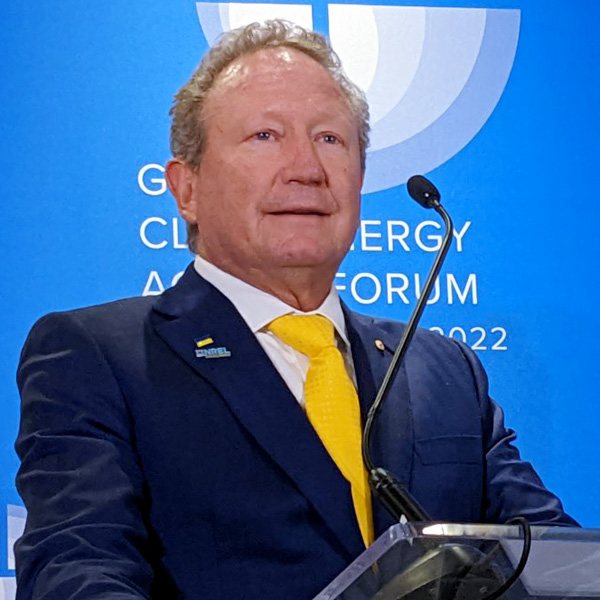PITTSBURGH ― In debates over climate change and the urgent need to decarbonize the world’s energy systems, heavy industries ― such as steel, cement and chemicals ― are typically held up as potentially insurmountable obstacles: industries that produce things we can’t live without while generating carbon emissions we can’t live with.
Taking up that challenge was a key theme at last week’s Global Clean Energy Action Forum, where over three days, government and business leaders from 34 countries issued a range of announcements focused on slashing those hardest-to-slash emissions.
U.S. Energy Secretary Jennifer Granholm opened the conference Wednesday evening with the rollout of the Department of Energy’s new Industrial Heat Shot, the sixth in its series of “Earthshots” aimed at pushing forward innovation across a spectrum of clean energy technologies. With heavy industry accounting for 30% of direct carbon dioxide emissions in the U.S., the initiative is targeting CO2 from the high-heat processes used to transform materials ― like iron into steel – with the goal of an 85% reduction by 2035.
The strategies to be pursued include electrification of heat processes, transitioning to lower-carbon fuels such as hydrogen, geothermal and nuclear, and developing new chemistries and biofuels, according to a DOE press release.
Setting the tone for the conference, Granholm described the Industrial Heat and other DOE Earthshots as audacious and ambitious but achievable, and invited other nations to join the effort, which, she said, “will be the story of the 21st century.”
Granholm followed up the Industrial Heat Shot with Thursday’s release of the funding announcement for the development of regional green hydrogen hubs, which will draw on $7 billion from the Infrastructure Investment and Jobs Act (IIJA). Industrial applications, including industrial heat and steel and cement manufacturing, are among the primary targets for the demonstration hubs. (See DOE Opens Solicitation for $7B in Hydrogen Hubs Funding.)
At the GCEAF closing ceremony on Friday, Granholm also announced that pledges from 15 countries and the European Commission will provide $94 billion to be used to fund a rapid acceleration of clean energy demonstration projects globally through 2026. The U.S. kicked off the drive to raise the money with a $21.9 billion contribution in June, after a report from the International Energy Agency estimated $90 billion in clean energy demonstration projects would be needed by 2026 to ensure that essential new technologies can be commercialized and scaled by 2030.
In addition to the U.S., Australia, Canada, the European Commission, Finland, France, Germany, Japan, the Netherlands, Norway, Poland, the Republic of Korea, Singapore, Sweden, the United Arab Emirates and the United Kingdom contributed to the fund.
Another DOE announcement, also released on Friday, highlighted $4.9 billion from the IIJA that will be used to accelerate the commercialization and scaling of carbon capture, transport and storage systems. The money will be spread over three initiatives with the goal of siting, permitting and building carbon capture and storage (CCS) projects capable of storing at least 50 million metric tons of CO2. Funding will also go to CCS demonstration projects that can be easily replicated and deployed at heavy industry facilities and power plants, according to the announcement.
A Carbon Removal Launchpad
Although not an official United Nations event, the GCEAF served as a launching pad for new national and international commitments and actions that will be brought forward at the 27th UN Climate Conference of the Parties (COP27) set for Sharm El Sheikh, Egypt, in November.
Thus, the industrial decarbonization announcements at the conference — and the intensive focus on carbon dioxide removal (CDR) and green hydrogen — seemed to signal a new level of commitment to these technologies, which still raise skepticism among some environmental and clean energy advocates.
Initiatives advancing both technologies led announcements from Mission Innovation (MI), the international consortium founded in 2015 to accelerate the research and innovation needed to drive widespread deployment of clean energy.
Speaking at a Friday session, Drew Leyburne, Canada’s assistant deputy minister for energy efficiency and technology, reported that MI is “initiating a global push for testing and demonstrating CDR technologies in the lead-up to COP27.”
The six nations in this “Carbon Removal Launchpad” — the U.S., Canada, Saudi Arabia, Norway, Japan and the United Kingdom — will work together “to build and fund pilot-scale and demonstration projects in the CDR space, and to support monitoring and verification efforts to ensure that CO2 is durably stored,” said Leyburne, who also chairs MI’s steering committee.
“It is imperative that we demonstrate the viability of CDR technologies and invest in them in a way that gives the industry the confidence to invest in critical CDR infrastructure, that gives the public confidence in CDR as an essential tool to address climate change, and then ensures that communities receive economic, social and environmental benefits from CDR projects,” he said.
MI also launched a green hydrogen action plan at the conference, but the major announcements — and investments — came from leaders in the steel and iron industries such as Luxembourg’s ArcelorMittal (NYSE:MT) and Australia’s Fortescue Metals Group (ASX:FMG).
Irina Gorbounova reported on ArcelorMittal’s efforts to decarbonize its steelmaking processes with a mix of green hydrogen, renewable energy and “potentially disruptive technologies that can help us accelerate this [work].” The company’s XCarb Innovation Fund, which Gorbounova heads, recently invested $5 million in H2Pro, an Israeli startup pioneering a new approach to green hydrogen electrolysis that could be both cheaper and more efficient than traditional electrolysis.
It has also invested $30 million in LanzaTech, a carbon recycling company, with which it is developing carbon-capture technology at its steel plant in Ghent, Belgium.
Gorbounova sees the role of ArcelorMittal and other heavy industry players as offering entrepreneurs “unique industrial settings … to test their solutions and to establish the technological viability and also industrial scalability.”
‘Stop Hanging Back’
 Andrew Forrest, Fortescue Metals | © RTO Insider LLC
Andrew Forrest, Fortescue Metals | © RTO Insider LLCFortescue Metals and its chair Andrew Forrest made headlines last week with its rollout of a $6.2 billion plan to decarbonize its iron ore operations by 2030, followed by a second announcement at GCEAF of a new partnership with the DOE’s National Renewable Energy Laboratory (NREL).
The goal for the company’s 10-year, $80 million investment, Forrester said at a small press conference on Thursday, is to help scale and commercialize the innovative technologies developed at the lab, which will then allow more companies to decarbonize.
“With NREL, Fortescue aims to create the world’s leading science and share it with the world so investors like us stop hanging back, stop being concerned that if they commit to a technology and build out a manufacturing system, the [next new] technology will come along and supersede their own new plant,” Forrest said.
“NREL simply gives us the confidence and … will give the world the confidence to really invest and invest aggressively and heavily,” he said.
By 2030, Kurt-Christoph von Knobelsdorff, CEO of German hydrogen and fuel cell company NOW GmbH, also wants to upend heavy industry worldwide with 70 green steel plants, 40 net-zero aluminum factories and 60 zero-carbon ammonia facilities.
But reaching those targets will mean answering some tough questions, von Knobelsdorff told the audience at the MI session on Friday. “How do we change the fuels in those industries?” he said. “How do we get the circularity [of supply chains] working better in these industries? How do we [approach] the efficiency of these industries in a different way? And how do we change fundamental industry processes?”
Echoing Forrester, Leonore Gewessler, Austria’s minister for climate action, environment and energy, stressed the urgency of developing the technologies to cut industrial emissions now. Evoking the climate crisis, she said on Friday, “We cannot wait sector by sector; [there] needs to be combination of industries. … There are 25-year investment cycles in industry, so we need to be there now for every single one of those decisions.”
Calling for radical decarbonization, Gewessler announced that Austria is contributing €250 million to MI’s industrial decarbonization efforts.
“This decade is crucial,” she said. “We need to be smarter and faster,”






